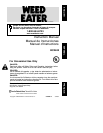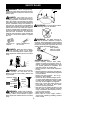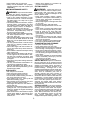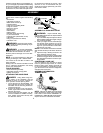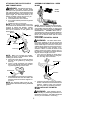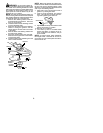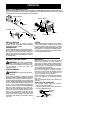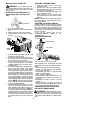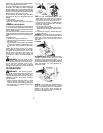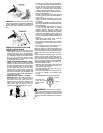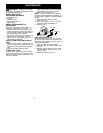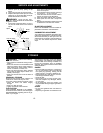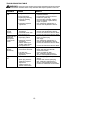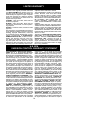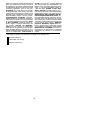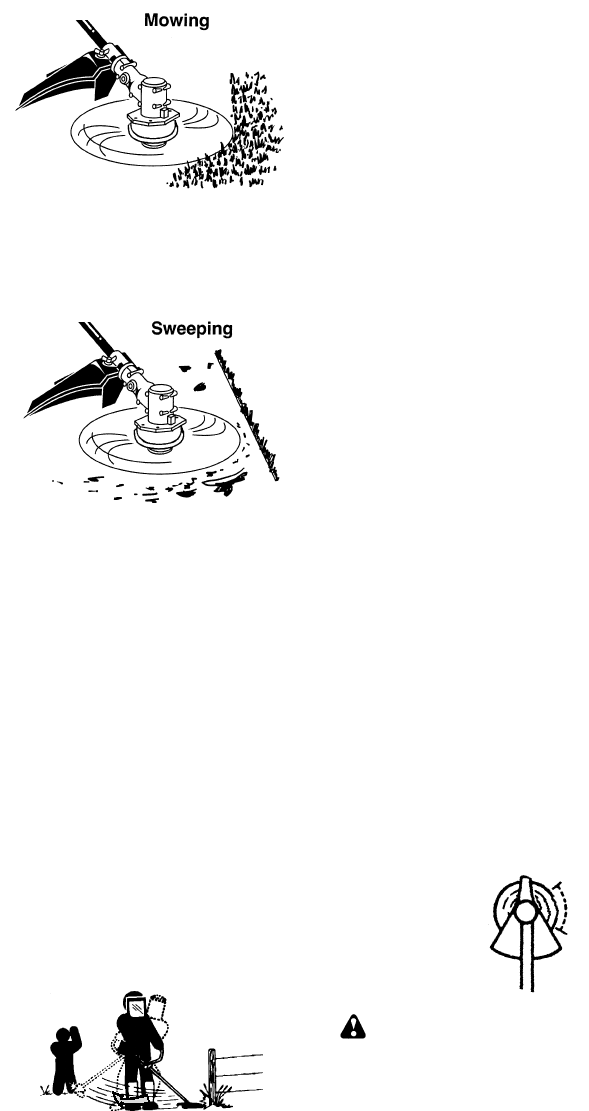
10
SWEEPIN G
-- The fanning action of the r otating
line canbe used to blowawayloose debrisfrom
an area. Keep the line parallel to and above the
area sur face and sw ing the tool fr om side to
side.
OPERATING INSTRUCTIONS FOR
USE WITH WEED BLADE
S
Blade Thrust
is a reaction that only occurs
when using a bladed unit. This reaction can
cause s erious injury such as amputation.
Carefully studythis section. Itis importantthat
you under stand w hat causes blade thrust,
how you can reduce the chance of its
occurring, and how you can remain in control
of unit if blade thrust occurs.
S
WHA T CAUSES BLADE THRUST
--
Blade
Thrust
can occur when the spinning bl ade
contacts an object t hat it does not cut. This
contact causesthe bladeto stopfor a ninstant
and then suddenly move or “thrust” a way
from t he object that w as hit. The “thrusting”
reaction can be violent enough to cause the
operator to be propelled in any direction and
lose control of the unit. The uncontrolled unit
can cause serious injury if the blade contacts
the operator or others.
S
WHEN BLADE THRUST OCCURS
--
Blade Thrust
can occur without warning if
the blade snags, stalls, or binds. This is
more likely to occur i n areas where it is
difficult to see the material being cut. By
using the unit properly, the occurrence of
blade thrust will be reduced and the
operator will be less likely to lose control.
S
Cutonly grass, weeds, andwoody brush u p
to 1/2 inch in diameter with the weed blade.
Do not let the blade contact material it
cannot cut such as stumps, rocks, fences,
metal, etc., orclusters of hard, woody brush
having a diameter great er than 1/2 inch.
S
Keep the blade sharp. A dull blade is more
likely to snag and thrust.
S
Cut only at full throttle. The blade will have
maximum cutting power and is less likely to
bind or stall.
S
“Feed” the blade deliberately and not too
rapidly. The blade can thrust away if it is fed
too rapidly.
S
Cut onlyfrom yourleft to yourright. Cuttingon
right side of the s hield will thr ow debr is away
from the operator.
S
Use the shoulder strap and keep a firm grip
on the unit with both hands. A properly
adjusted shoulder strap will support the
weight of the unit, f r eeing your arms and
hands tocontrol and guidethe cutting motion.
S
Keep feet comfor tably spread apart and
braced for a possible sudden, rapid thrust of
unit. Do not overr each. Keep firm footing and
balance.
S
Keep blade below waist level; it will be
easier to maintain c ontrol of unit.
S
Donot raise the engine above your waist as
the blade can come dangerously close to
your body.
S
Do not swing unit with such force that you
are in danger of losing your balance.
Bring the engine to cutting speed before en-
tering the material to be cut.If the blade does
not turn whenyou squeeze the throttle trigger,
make sure tube is fully inserted into the en-
gine.
Always release the throttle trigger and allow
engine to return to idle speed when not cut-
ting. The blade should not turn while the en-
gine is running at idle. If the blade turns atidle,
do not use your unit. Refer to the CARBURE-
TOR ADJUSTMENT section or contact your
authorized service dealer.
S
Maintain good firm footing while using t he
unit. Do this by planting feet f irmly in a
comfortable apart position.
S
Cut w hile swinging the upper part of your
body from left to right.
S
Asyoumoveforward tothe next areatocut,
be sure t o maintain your balance and
footing.
Cut using the 2
o’clock to 4 o’clock
position of the
blade
2 o’clock
4 o’clock
RECOMMENDED CUTTING POSITION
WARNING:
The operator or others
must nottry toclear awaycut material withthe
engine running or the blade t urning to avoid
serious injury. Stop engine and blade before
removing materials wrapped around blade or
tube.



